2019 Amateur and Commercial Winemaking Competition
It’s that time of year again!
Musto’s 2019 Amateur and Commercial Wine Competition is just around the corner. Every year, home and commercial winemakers get the chance to show off their wines in a blind tasting judged by knowledgeable, seasoned wine judges in a series of blind tastings.
Click HERE to download all of your paperwork!
Who can enter?
This wine competition is open to any amateur winemaker, commercial winemaker or winery. Wine entry must be made by a winemaker, not purchased and re-bottled and used as an amateur wine maker entry. Judge may not judge a wine they have submitted.
How do I enter?
Send Musto Wine Grape your bottled wine by the deadline of November 16th at 12PM.
What can I submit?
A wine entry is a still bottle of wine and submitted for entry in a 750ml wine bottle. Ice wines or late harvest wines may be submitted in a 375ml wine bottle, however if 375ml please send 2 – 375ml bottles. Sparkling wines must be submitted in a champagne style bottle with the proper closure. All bottle entries must be free of any labeling or identifying markings. However, each must be marked with category number, winemaker(s) name, wine ingredients, percentages & vintage.
What is the judging process?
Judging of wines will be performed on a 20 point award system. Each wine will be judged on its own merits and not compared to any others in its category. Gold, Silver and Bronze medals will be awarded within each category and based on the 20 point system. The Best of Show award(s) will be those wine entries that are superior within a given category. All award decisions made by the judges and/or sponsors, are final.
We’re doing something different this year!
This year, in order to allow winemakers a more thorough and individualized analysis of their submitted wines, Musto Wine Grape Company staff will be personally judging and performing sensory analyses on each bottle. This year’s competition format will allow for more time, thought, and comments to go into each individual’s submission, yielding a more comprehensive understanding of each wine. Because of this, entries will be capped at 300 bottles.
What are the categories?
Wine entries made from grapes and juice based wines will be judged and awarded in their own category. Wine entries made from kits and fresh processed and concentrated juices will be judged and awarded in a kit category.
Is there a deadline?
There sure is – have your wines sent to Musto Wine Grape, 101 Reserve Rd, Hartford CT 06114, by November 16th at 12PM.
Is there a fee?
Entry fee for a single wine entry will be $11.00 and $9.00 each for 2 or more entries submitted at the same time. Make checks payable to Musto Wine Grape Company in U.S. dollars only.
Can I send in a labeled bottle?
No. All bottle entries must be free of any labeling or identifying markings. However, each must be marked with Category number, winemaker(s) name, wine ingredients and percentages & vintage.
How can I get it to you?
All shipments are the entrant’s responsibility therefore packaging must be able to withstand considerable handling and shipping costs are the entrant’s responsibility. COD’s or postage due will be rejected. If an entry bottle is received damaged, we will make every effort to contact the entrant and notify them of the damage. Check with your shipper as to requirements for shipping wine, we suggest shipping via FedEx.
When are results announced?
There is an awards ceremony held every year to reveal this year’s results, which will be held in Spring 2020 (exact date TBA) and of course you can also see the results announced on Musto’s website, www.juicegrape.com. All entrants will receive a copy of the judging worksheet and a copy of the winning results.
So what do I do now?
Send us your wine ASAP! Since entries will be capped at 300, we won’t be able to accept any after this. Look out for an announcement on Facebook and our website that lets you know when we have received our maximum entries.
Don’t make these mistakes this harvest season!
Avoid these all too common mistakes this harvest!
With all the planning, excitement, energy, and potential money you’ve put into preparing for harvest time, the last thing you want to do is make a silly mistake that may put the quality of your wine in jeopardy. The following is a list of pitfalls to be aware of. Heed these words to the wise and save yourself a headache in the future.
1) Inadequate space for your volume
Overflowing, bubbling, fermenting wines can make an absolute mess. You want to fill any vessel no more than 3/4 full pre-fermentation unless you’re both physically and emotionally prepared for the cleanup. You will also needlessly lose volume, yeast, and nutrient, in addition to your mind. Multiple tanks or carboys of various sizes will be your saving grace here.
2) Not cleaning properly
Clean, sanitize, repeat.
The importance of proper cleanliness and sanitation practices from the get go cannot be stressed enough. B-brite, One Step, soda ash, and Proxycarb are all cleaning agents. Potassium metabisulfite + citric acid is a sanitizing solution.
You want to clean and then sanitize, not sanitize and then clean. Don’t let anything with residue of fruit, juice, or must sit out for longer than necessary. That means that before you finish up for the day, your work space should be nice and clean and ready for the next day. Otherwise you will attract fruit flies, which can lead to VA issues in the wine. (Not to mention they’re a pain and difficult to get rid of anyway.)
3) Underestimating the need for nutrients
Adding yeast nutrients may seem like an optional add on, but why wouldn’t you want to ensure that your yeast have all of the nutrients that they need to be happy and healthy and get your juice to become the wine of your dreams? Some yeast strains almost require the addition of them to work well. There’s no harm in using them, but there can definitely be harm in choosing not to.
Lack of nutrients can lead to stressed yeast which can produce off odors (H2S, the smell of rotten eggs or cabbage) that are very difficult to get rid of.
4) Skipping steps/guesstimating
Eyeballing an SO2 add, rounding up on Brix levels, or having a “eh, it’s more or less correct” attitude when making wine can really complicate your life down the road. Sure, some people see winemaking as only art and some see it as only science; but the wise see it as the perfect blend of both.
- do not generalize
- do not come to conclusions without taking all variables into account
- do not guestimate unless you know for a fact that a “more or less” mindset is applicable in a given circumstance
5) Forgetting that there’s a difference between US and metric system
Freshen up on your middle school math conversions so you can quickly maneuver between gallons and liters and ounces and grams. Some labels include g/L and lb/gallon. Double (or triple) check your math to be sure you’re consistent and working with the same unit of measurement. These early stage additions very much set the tone for the wine throughout its whole life so you want to get it started on the right foot. Online calculators like WineMaker Mag’s sulfite calculator and winebusiness.com’s conversions caulculator can be really useful because you can toggle back and forth between these systems depending on what you are most accustomed to.
LODI RULES in Sustainable Farming
So, you want to learn more about Lodi wine region?
Are you are interested in California wine? If so, chances are you’ve been on the up and up with what’s happening in Lodi. A fantastic climate, strong traditional roots, and multiple generations of winegrowers are paving the way for sustainability measures. This has led to the creation of the LODI RULES seal, a green stamp appearing on the back labels of certified wines much as you would find a “USDA Organic” sticker. Click here to see which of our Lodi wine grapes are LODI RULES certified –> LODI RULES – Musto Wine Grape
As California’s original sustainable viticulture certification program, this seal is representative of a producer’s commitment to stewardship and respect for the land. It is a symbol of transparency in all things related to sustainable viticulture. The certification does not approve only one aspect of winemaking. It looks at the whole of the process, from farm to vine to bottle. While over 150 wines bear the LODI RULES seal, not just any winery can use this seal on their labels. The wines must have 85% certified sustainable grapes and be able to prove this. This then gets confirmed through third party accreditation and auditing.
There are two layers to the accreditation
1. Wineries must agree to “The Standards” of the certification, which include 100+ sustainability measures, in addition to following a unique pesticide risk model. The Standards are comprised of sustainability related to
- business
- human resources
- ecosystems
- soil
- water
- pests
2. Wineries must follow the Pesticide Environmental Assessment System (PEAS), used to gain an understanding of the impact of pesticide use within the vineyard. This is then used to generate a quantifiable environmental impact unit through which the effects and range of pesticide application can best be understood within the local ecosystem.
The Lodi AVA is setting a fantastic example by supporting the land that retains some of this country’s oldest vines. Lodi Rules is imparting a new standard in its meticulous regulations, leading other wine regions following suit after realizing how successful this certification has been for the region. Keep up to date with the progressive measures this winemaking region is taking to best care for their land, and be sure to look for the LODI RULES label on your next Lodi bottle. And this fall, be sure to find your very own Lodi wine grapes here at Musto Wine Grape Co.
2019 Winemaking Class Schedule – *UPDATED*
Musto Wine Grape’s Updated Winemaking Class Schedule
Oak Alternatives Class
- Saturday August 17th at 10:00AM
- Cost: $4.99 + tax
- Link: http://www.juicegrape.com/oak-alternatives-class/
Fermentation Planning Class
- Saturday August 24th at 10:00AM
- Cost: $4.99 + tax
- Link: http://www.juicegrape.com/Fermentation-Planning/
Making Consistently Flawless Wines with Daniel Pambianchi
- Focused in fermentation science, both alcohol and malolactic, understanding and managing pH and TA changes during fermentation, and advanced wine analysis skills.
- Saturday September 7th
- Cost: $250.00
- Link: http://www.juicegrape.com/Seminar-Daniel-Pambianchi/
Winemaker Bootcamp
- Musto’s hands on winemaking class. Learn how to make wine in class from start to finish.
- Session 1: Starts Saturday September 21st – 9:00AM-12:00PM for 5 consecutive weeks
- Sessions 2: Starts Saturday October 19th at 1:00PM-4:00PM for 5 consecutive weeks
- Cost: $150.00 for class
- Cost of Adding Grapes: TBD – depends on which grapes the class is working with. You will find out the this cost the day of class
- Link: http://www.juicegrape.com/EDUIBL-5-WEEK-WINEMAKING-BOOTCAMP/
Winemaking 101
- Learn the basics of making wine at home
- Date: TBD
- Cost: $75.00
- Link: http://www.juicegrape.com/Education-Intro-to-Wine-Making-101/
Winemaking 201
- Learn the basic lab skills needed to take your winemaking to the next level
- Date: TBD
- Cost: $75.00
- Link: http://www.juicegrape.com/Education-Intro-to-Basic-Lab-201/
We look forward to seeing you in class! Please email Christina at cmusto@juicegrape.com with any questions about our winemaking classes.
Grower Jeff Bitter talks about Veraison in his vineyard for Musto Wine Grape Company Winemakers
It’s that time of year again!
Our grapes are going through veraison in California.
Veraison occurs when the berry transitions into the ripening stage. From now forward the berry will increase in sugar concentration until it is harvested at the desired brix level. Grapes for sparkling wine or champagne are harvested around 17 brix and grapes for still wine are harvested around 25 brix. The brix level will determine the alcohol level in the wine. For example, a grape picked around 25 brix should create a 12.5% alch by volume wine.
Check out our video with Grower – Jeff Bitter as he walks us through his vineyard, verasion, and what he has been working on in the vineyard thus far.
Veraison in the Vineyard with Jeff Bitter for Musto Wine Grape Co. LLC.
Email Sales@Juicegrape.com or call 877-812.1137 for more details
about the 2019 Harvest!
2019 Winemaking Class Schedule

Start the year off right with Winemaking Classes! Learn new tricks and tips, or start your first batch.
Musto Wine Grape has a winemaking class for everyone!
Free Winemaking Classes:
-
Working with Chilean Wine Grapes & Juices – Saturday May 4th at 10:00AM -
New England Viticulture – Saturday May 18th at 10:00AM -
SO2 Management – Saturday July 13th at 10:00AM -
Working with Hybrid Grapes in the Winery – Saturday July 13th at 10:00AM
$4.99 Winemaking Classes:
- Oak Alerntatives Class – Saturday August 17th at 10:00AM
-
Fermentation Tips & Planning – Saturday August 24th at 10:00AM
-
Making Wine from Juice – Saturday September 14th at 10:00AM
Winemaker Bootcamp Classes:
-
Chilean Bootcamp – Starts Saturday May 25th at 9:00AM
Daniel Pambianchi Seminar:
-
Saturday September 7th, 2019
Winemaking 101:
-
Spring classes: TBD Fall 2019
Winemaking 201:
-
Spring classes: TBD Fall 2019
Making Italian Amarone from Juice: How to Drink like a Millionaire, but Make Wine on a Budget
A Little About Amarone:
The Italian Amarone wine is famous for its strong, tannic character and full bodied flavors of dried fruit. Rich and complex, it is a benchmark Italian wine, often challenging to recreate until now. Amarone develops its rich and complex character from partially drying the grapes, then fermenting them, decreasing the fruit to skin ratio. The higher levels of skin contact will give the intense tannins and dried fruit character that the style is known for.
How to Make Amarone/Amorosso from Fresh Juice:
When making Amarone with fresh juice, there are certain ingredients that you may add as the winemaker to help replicate the classic style and methods. To increase the skin contact for the juice, you can purchase an All-Grape add pack to add into your bucket of juice. The All-Grape pack is simply just that, wine grape skins and juice, designed to add more tannins and complex flavors to juice. The tannins found in the grape skins will become soluble in the juice and add more of the traditional Amarone character to it.
Juice Options:
Winemaking Kit Options:
A way to increase the tannin content at fermentation and mimic the classic style is by adding supplemental tannins. Yeast naturally consume some tannins throughout their metabolic process of fermentation. Without adding additional tannins, they will consume some of the grape tannins that give Amarone its unique style. By adding some very cost effective fermentation tannins such as oak dust or FT Rouge, additional tannins will be available to the yeast for their process, therefore preserving the grape tannins for the consumer. FT Rouge is a natural oak derived tannin that will not only provide stronger tannic character, but will also help to enhance and secure color. Apply FT Rouge at 1gram/gallon. Oak dust will also supply some “sacrificial tannins” to the yeast fermentation process. The yeast will consume these tannins, leaving the more favorable, smother grape tannins for the consumer.
Winemaking Add Ons:
- FT Rouge
- All Grape Pack
- Oak Dust
Another way to enhance your process of making Amarone from juice will be in your yeast and bacterial selection. Some yeasts that will enhance the rich fruit character of the Amarone juice are BM 4×4 and RP15. Both yeasts have a higher temperature tolerance and will help to secure the rich color. To recreate a traditional Amarone closely, the perception of acidity will need to be reduced. Using malo-lactic bacteria to metabolize the harsher malic acid, and turn it into lactic acid, which has a smoother, creamier mouthfeel, is a vital step in creating a traditionally styled Amarone. This bacterial fermentation can take place at the same time as the primary yeast fermentation, so that the bacteria will benefit from the available nutrients and heat generated via the yeast fermentation. For an individual bucket, we sell a pouch of bacteria that are very easy to use. Simply wipe the pack with sanitizer and stir it into the wine. The bacteria will finish up their fermentation shortly after the yeast finish their fermentation; approximately 2-3 weeks after it is inoculated.
Yeast Suggestions:
To round out the full bodied flavor and profile of Amarone, the winemaker will have to add oak to create a balanced bouquet. After fermentation, the winemaker should consider the addition of oak via a traditional barrel or a supplement, such as oak chips or staves. These will add additional tannic character, creating the Amarone most closely to its traditional style.
Aging Additions:
by the Winemakers at Musto Wine Grape
If you are interested in sourcing Italian Juices for winemaking please contact us at sales@juicegrape.com or 877-812-1137.
Black Muscat: A Grape by Any Other Name
The oldest genetically traceable family of grapes is the Muscat family. Over the centuries, the grape has traveled around the world and transformed itself through many genetic mutations. One of the most well known genetic crosses of the original Muscat grape is the Black Muscat. Black Muscat is a cross of the Schiava Grossa and the Muscat of Alexandria. The grape has very large, plump berries, with white flesh and black skin. The grape has intense, sweet floral and candy-like flavors.
Black Muscat can be used for a very wide variety of wine making purposes. It can be pressed to produce a white juice, that has been used in famous dessert wine productions as well as left on the skins to produce a flavorful rose or red table wine. It is popularly used for table wine production in California, China, and Eastern Europe. Quady Winery in California has gained fame and many acclimations over their dessert wine, Elysium, produced from the Black Muscat grape. The intense florals and sweet fruit flavors that are found in the unprocessed grape, translate in the finished wine product. Big flavors of raspberry jam and candied citrus make the wine deliciously sweet with enough acidity to create a harmonious balance. Because the wine can be made in so many different styles, the winemaker has many choices to control the outcome of the final product. If creating a dessert style wine, beneficial yeast strains would be Vin 13 or R2 to promote the complex floral aromatics. If creating a rose or table wine, QA23 or 71B yeast strains will help to promote aromatics and to capture the ripe red fruit flavors. Skin contact time will be critical; a few hours on the skins will produce a flavorful rose and then full maceration/fermentation on the skins will create a fruit forward table wine.
Musto Wine Grape has had such wonderful results with this grape, that Frank Musto has planted his own fields of this varietal. The vines are coming up on their 20th birthday, generating large but complex fruit and excellent yields. Frank Musto’s Black Muscat has started being harvested and is arriving in Hartford currently. Brix levels are averaging in the mid 20’s with smooth acidity. We are looking forward to making a fruit forward rose this year with some of the fruit. It is exciting to create a new style of wine with such an ancient, treasured strain of grape.
by the Winemakers at Musto Wine Grape
Teroldego: Adding Old World Style to New World Wines
Teroldego is an ancient varietal from the northern mountains of Italy. Originating from Trentino, a mountainous region on the Austrian border, this incredibly dark skinned grape is the genetic parent of Lagrein and Syrah. The grape is a prolific grower, bearing heavy yields while maintaining quality. The thicker skin makes for a more stable grape on the vine and allows for a longer hang time, generating a higher Brix level and more complex phenolics. They often use pergolas to help control the vigor of the vine itself.
The thicker skin of the Teroldego grape lends tremendous tannin content to the finished wine. Upon vinification of the grape, flavors of baking spices, red fruits, and pine are generated. Hints of tar and leather come most directly from the grape skin. This grape will add a tannic punch to any blend and can help to add mouthfeel to a thinner red variety. Some yeasts that will help to amplify the fruit notes and mouthfeel of the Teroldego are D254 and D80. This grape can also help add color and can be integrated at crush in a varietal with color securing problems. While Teroldego can be drunk early, it really starts to shine after 5 years of aging. In the aging process, the tannins will link up and form longer chains that will be perceived as a smoother mouthfeel. If the consumer doesn’t mind a more aggressive, bold wine, it can be enjoyed early, a perfect accompaniment to grilled meats.
Teroldego is an ancient variety with a traditional, earthy old-world style. While we may not be able to travel to Italy to create an old-world style wine, we now can bring Italy to us, in the form of this beautiful grape.
Numbers collected on 9/14/18 –
Brix=24.2
pH=3.62
TA=4.26g/L
YAN=276.8
by the Winemakers at Musto Wine Grape







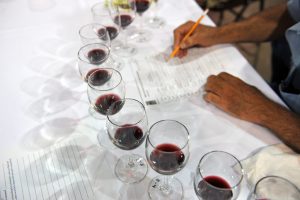
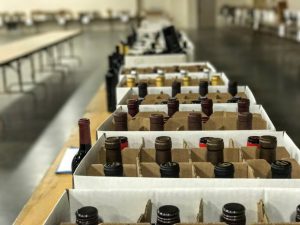
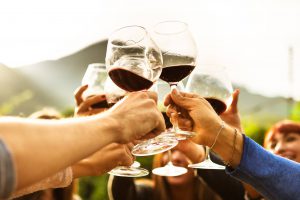



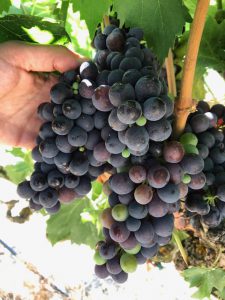
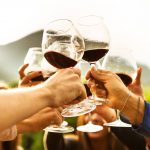

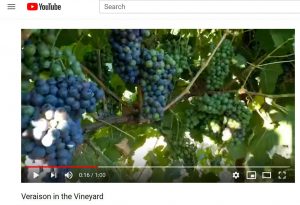
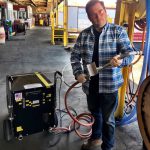

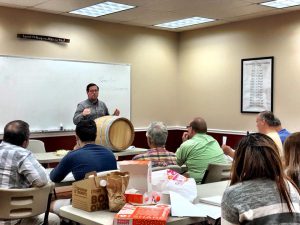
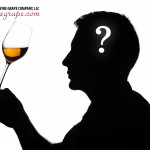

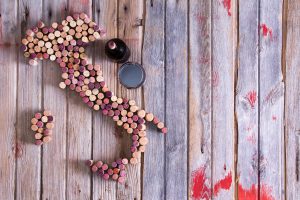

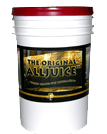
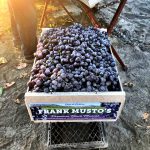
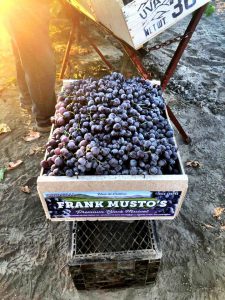
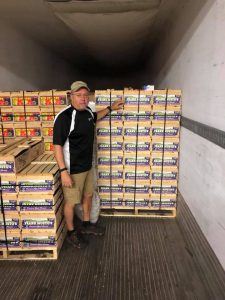
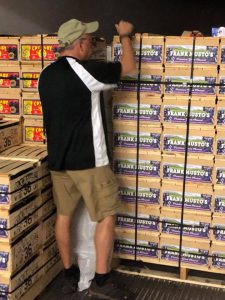
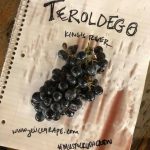
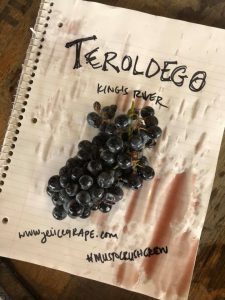
Recent Comments